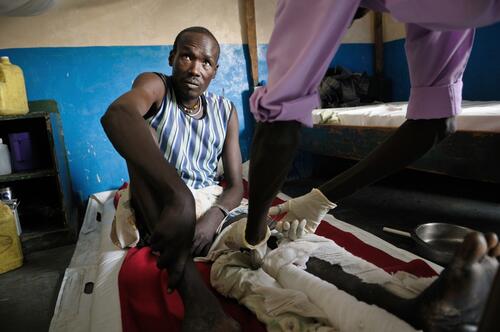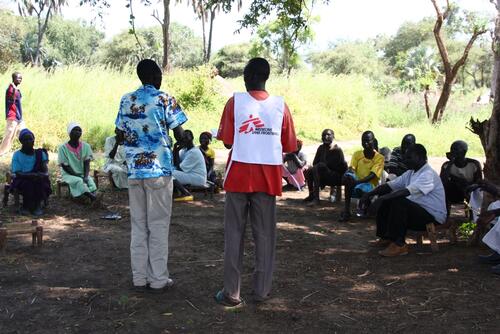She sits very quiet in the group of smiling and yelling children. Not more than 14 years old, wearing an old and worn out nightgown, she sits bent over a piece of paper, fully concentrated on drawing what she is most afraid of.
Psychologist Julia Stempel leans over to see what the young girl is drawing. Most of the paper is taken up by a big aeroplane.
“We see a lot of the children drawing aeroplanes,” explains Stempel. “The children are asked to draw what frightens them the most. And almost everyone draws an aeroplane. They say it’s the aeroplanes that forced them to flee.”
By asking the children to draw what they are afraid of, Julia Stempel and her team of five psychosocial workers and ten community workers give them a chance to express their feelings. They also ask the children to draw a second picture with a safe place, eliciting the feeling that ‘the danger is over now’. The team is trying to help the children understand that they can stop being afraid.
Singing, drawing and role play are a few of the tools the mental health team in Doro use to reach out to the refugees, making them understand that “our mind can get ill just as our body can get ill” as Stempel puts it.
Depression affects the whole family
Many refugees are living with chronic stress, which manifests itself in psychosomatic complaints like headache or stomach ache affecting not only the patient but the whole family.
“A grandmother in one of the families was suffering from a very bad depression, and just spent her day lying passive in the hut, doing this for the last three months,” says Stempel. “The whole family lived around her in that hut. Her condition, the experiences of fleeing plus the living conditions in the camp were so stressful for the family, that one of her granddaughters stopped talking, lost appetite and started showing depressive symptoms too. Having two members of the family suffering in that way put an extra level of stress on the family, who are already under a lot of pressure. That's where we try to reach out and help.”
Through group sessions, home visits and individual consultations, the mental health team is trying to reach as many people as possible.
“The greatest success so far is seeing how people grasp the idea of mental health and can support each other,” says Stempel. “The discussions in the groups, when people open up and say 'I feel that as well', that's when I think ‘yes!’”
Since the beginning of the mental health program in Doro camp, MSF mental health workers have reached 16,489 people in group sessions both in the community and in health facilities. They have also seen 180 patients coming for individual consultations. In Jamam camp, MSF mental health workers carry out approximately 300 individual sessions of psychological first aid 50 individual consultations each month.
Since November 2011, MSF has been providing emergency assistance to refugees fleeing Sudan’s Blue Nile State and seeking refuge in Maban County, Upper Nile State. MSF provides medical services in four camps: Batil, Doro, Gendrassa, and Jamam, as well as conducts substantial water supply activities, including the management of boreholes and hand pumps. MSF runs three field hospitals, providing outpatient and inpatient services to the more than 100,000 people who have sought refuge in the camps.





